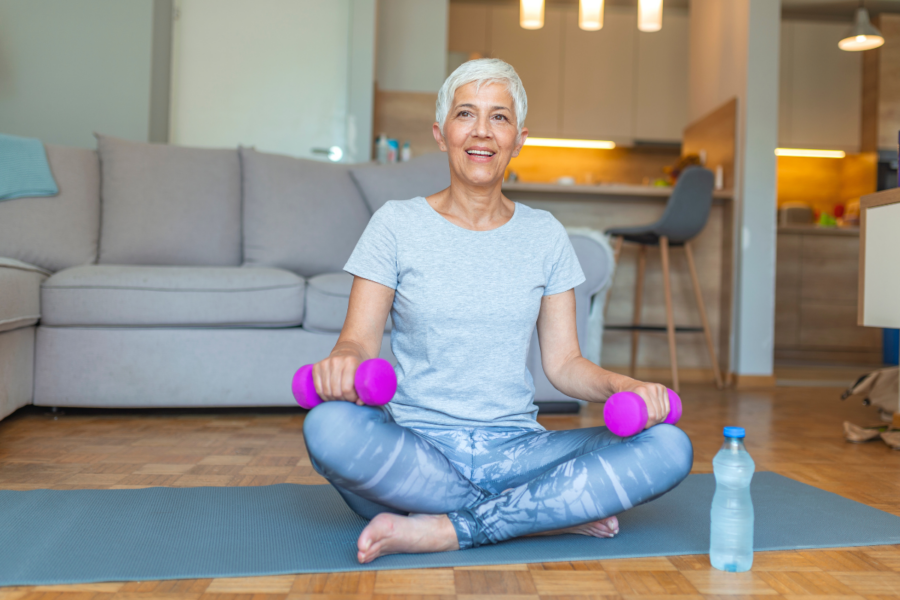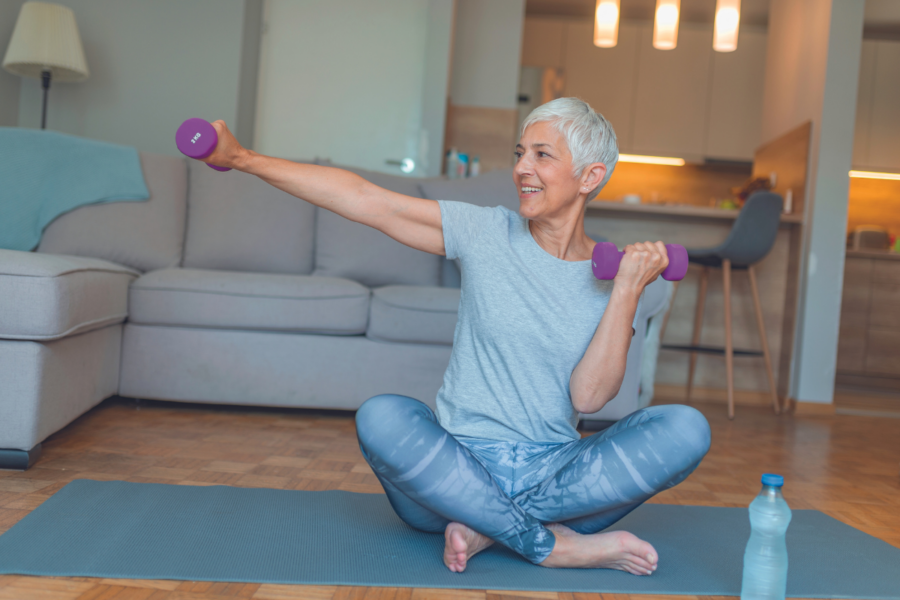Explore how lifting weights can enhance your health, vitality, and overall well-being as you navigate the challenges and opportunities of midlife and beyond.
Midlife is when resistance training becomes more important than cardio in terms of staying fit, as it helps keep your bones, muscles and joints strong, says longevity and fitness expert Victoria Anderson. Read her eight top reasons for picking up weights, as well as her tips for resistance training, below.
1. Builds lean muscle
Muscle mass and function reduces as individuals age, declining by approximately one per cent per year from around the age of 30, and then accelerating to around 1.5 per cent per year by the age of 50¹.
Eventually, we begin to lose around 3-8 per cent of our muscle mass each decade, which later in life can prohibit the ease of carrying out day-to-day tasks such as getting up from a chair or the floor, climbing stairs or being able to walk further distances².
Lower levels of muscle mass and strength have been associated with a higher risk of all-cause mortality compared to those with higher levels of muscle mass³. By engaging in resistance training early and consistently, individuals not only mitigate the effects of age-related muscle loss but promote the growth of lean muscle tissue, which contributes to overall wellbeing and longevity.

2. Strengthens bones
Resistance training has been demonstrated to increase bone mineral density, which reduces the risk of osteoporosis and fractures, particularly as we age.
From midlife and beyond, our risk of falls and therefore our risk of fractures increases. Resistance training can help to activate osteoblasts, which promotes the bone-remodelling process and, in turn, creates density, strength and more resilience in our bones to help prevent osteoporosis⁴.
3. Boosts metabolic health
Resistance training has been shown to increase insulin sensitivity, which means the body becomes more efficient at utilising insulin to uptake glucose into cells to reduce excess fat storage. This is particularly important for individuals with insulin resistance or type 2 diabetes, but also for the wider population in the prevention of type 2 diabetes and cardiovascular disease.
Strength training can also help reduce visceral fat, and by decreasing abdominal fat, strength training can improve overall metabolic health and insulin sensitivity. Studies have demonstrated improvements in insulin sensitivity following strength training interventions⁵.

4. Improves posture
Resistance training is essential when it comes to enhancing posture, offering a range of benefits that promote spinal alignment and overall musculoskeletal health. Through targeted exercises that strengthen key muscle groups like the back, shoulders, core and hips, resistance training helps correct muscle imbalances and weaknesses that contribute to poor posture.
Additionally, resistance training enhances core stability and flexibility, reducing the risk of postural deviations and alleviating common issues like rounded shoulders or excessive spinal curvature. With consistent practice and focus on technique, resistance training helps you stand tall and move with ease.
5. Increases joint stability
Resistance training has been shown to improve joint stability, by increasing the strength of the muscles that support the joints. This can lead to improved range of movement⁶ and proprioception of the joints, improving your stability⁷.
Proprioception is the brain’s cue to understand the position of your body and the movements required, and reduces your risk of not only falls but injuries. It also plays an important role in carrying out coordinated and precise movements. As you age, this becomes more important in understanding the position of your feet to reduce trips, and so that you don’t stumble into things or lose balance.

6. Enhances mental health
There is growing evidence to suggest that resistance training, similar to aerobic exercise, has many mental health benefits and can be used as a clinical management tool for anxiety⁸, to reduce symptoms of depression, and for stress management.
Strength training goes beyond just the physical benefits that exercise can bring; it can provide better mental health outcomes and reduce the feelings of mental health disorders. This in turn has essential benefits on our physical health, so the more we can use resistance exercise as a tool for both physical and mental wellbeing, the better the tool can be used to improve overall health and longevity. This is also vital as we age to help reduce the feelings of loneliness.
7. Reduces the risk of cognitive disorders
Cognitive function has been shown to be impacted by resistance training. Research suggests that regular resistance training can help to protect key areas of the brain which are especially vulnerable to Alzheimer’s disease⁹.
Resistance training can also improve memory and attention. These cognitive benefits become increasingly important as individuals age and may help reduce the risk of cognitive decline, dementia and cognitive frailty¹⁰.

8 Lowers overall disease risk
Resistance training has also been shown to reduce our risk of certain types of cancers, type 2 diabetes, cardiovascular disease, stroke, reduce cognitive disorders as you age and manage things like blood pressure and cholesterol, which, as you age, can also put you at greater risk of developing further illness.
The presence of one or more of these conditions can continue the chain of illness and metabolic syndrome, which further increases the risk of strokes, heart conditions and other controllable diseases.
Our risk for diseases increases naturally as we age so it’s essential to reduce the controllable risk as much as possible to remain independent. This will also help reduce our risk of all-cause mortality and promote overall longevity.

Things to consider when resistance training
1. Start with lighter loads/weights. If you are not used to body-weighted exercise, then this is a good place to start to prepare your joints and muscles for higher working loads and the demand placed upon then.
2. Increase the load incrementally. Too much load can over-stress the joints and body, and increase your risk of injury if your body is not familiar.
3. Weight is relative. Go at your own weight and not what others are using.
4. Combination is key. Ensure you use resistance training alongside cardiovascular exercise and a healthy diet for maximal results.
5. Be prepared. Warm up and perform mobility-based exercises before resistance training to prepare the body and reduce the risk of injury.
Victoria Anderson is a clinical exercise physiologist and founder of Longevity Health and Fitness.
For more about her work, visit longevityhealthandfitness.co.uk.
Words: Victoria Anderson. Images: Shutterstock.
References
- ncbi.nlm.nih.gov/pmc/articles/PMC2804956/#:~:text=Muscle%20mass%20decreases%20approximately%203to%20disability%20in%20older%20people
- ncbi.nlm.nih.gov/pmc/articles/PMC2453303/
- pubmed.ncbi.nlm.nih.gov/28991040/
- ncbi.nlm.nih.gov/pmc/articles/PMC6279907/
- journals.lww.com/acsm-csmr/fulltext/2012/07000/re sistance_training_is_medicine__effects_of.13.aspxhave
- pubmed.ncbi.nlm.nih.gov/36622555/
- ncbi.nlm.nih.gov/pmc/articles/PMC4477923/
- journals.sagepub.com/doi/abs/10.1177/1559827610368771
- sciencedirect.com/science/article/pii/S2213158220300206?via%3Dihub
- pubmed.ncbi.nlm.nih.gov/30272098/








